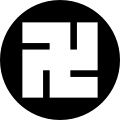Recreational research into Feudal Japan
Posts tagged swastika
Element of the Week: Swastika
Jul 19th (a Senshō (先勝))
Today we discuss a controversial mon element (and one you definitely cannot use in the SCA): the swastika. The swastika (卍 or 万字/manji), among many other symbolic uses, has always represented Buddhism in Japan, a use that dates back to the 5th century BCE in India. In Buddhism, the swastika represents dharma, harmony, and the balance of opposites.(en.wp:Swastika) Its use in Japan dates back to Buddhist use in the Nara period (710–794), and it acquired additional auspicious connotations due to phonetic associations with the word “man” (万), meaning “ten thousand”, and the idea of the virtues held by a Bodhisattva.(ja.wp:卍) After Christianity was banned following the Shimbara Rebellion in 1638, this was one of several mon popular among the “hidden Christians” who continued practicing in secret due to its subtle cross-shape.(Dower:148) Even in modern Japan, Buddhist temples are indicated on maps with a swastika icon. (While the Japanese swastika today generally points left, unlike the Nazi right-pointing swastika, both directions were used historically.) Due to the distance between Japan and Germany and Japan’s own wartime government basing its legitimacy on Shintō, not Buddhism, the fascist connotation is mostly absent.
Of course, in the Sengoku period, Buddhist connotations were the only connotations known to the Japanese, and samurai who wanted to display their religious faith might choose the swastika from the many religious symbols used in mon. Here we have two examples: the mon used by Tsugaru Nobuhira at Hirosaki Castle in 1610, and that used by Hachisuka Iemasa, who died in the Shimabara Rebellion in 1638.(SH:I,62) While the image of armies of soldiers marching with swastikas painted on their helmets may seem alarming today, it was no different than marching under the Christian cross in Europe.


